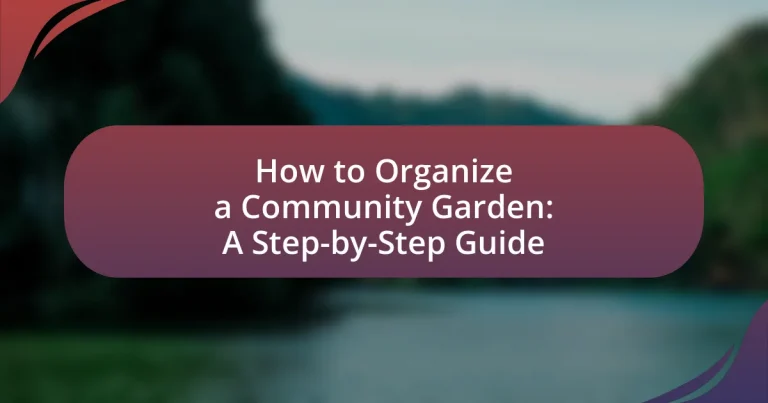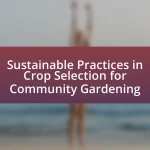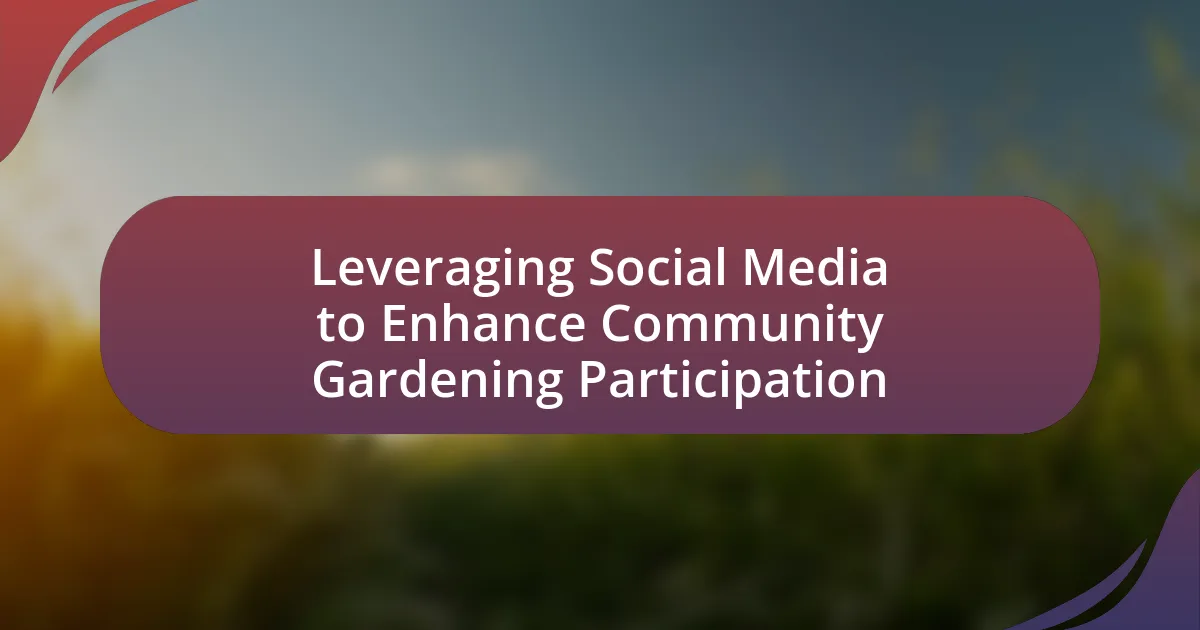A community garden is a collaborative space where individuals cultivate plants for personal use or community benefit, enhancing food security and social cohesion. This article provides a comprehensive guide on organizing a community garden, detailing essential components such as forming a planning committee, selecting a suitable location, and establishing governance structures. It also addresses the benefits of community gardens, including their positive impacts on local ecosystems, mental health, and community engagement. Practical steps for setting up a garden, maintaining it, and evaluating its success are outlined, along with strategies for overcoming common challenges and ensuring long-term sustainability.
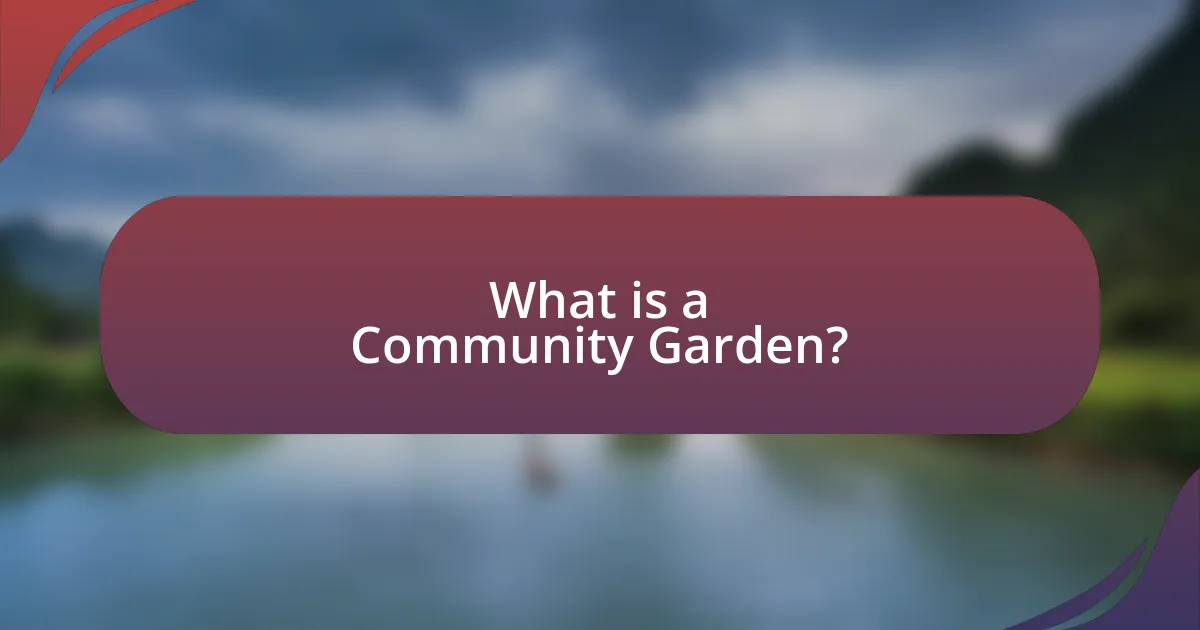
What is a Community Garden?
A community garden is a shared space where individuals come together to cultivate plants, typically vegetables, fruits, and flowers, for personal use or community benefit. These gardens promote social interaction, environmental awareness, and sustainable practices, often transforming vacant lots or underutilized areas into productive green spaces. Research indicates that community gardens can enhance local food security, improve mental health, and foster community cohesion, as evidenced by studies from the American Community Gardening Association, which highlight the positive impacts of such initiatives on urban communities.
How does a community garden function?
A community garden functions as a shared space where individuals come together to cultivate plants, typically vegetables, fruits, and flowers, for personal use or community benefit. Participants usually organize themselves into groups, establishing rules for garden maintenance, plot assignments, and shared responsibilities. This collaborative effort fosters community engagement, promotes sustainable practices, and enhances local food security. Research indicates that community gardens can improve neighborhood cohesion and provide educational opportunities about gardening and nutrition, as evidenced by studies from the American Community Gardening Association.
What are the key components of a community garden?
The key components of a community garden include designated plots for individual or group gardening, shared resources such as tools and water access, a community space for gatherings, and a governance structure for decision-making. Designated plots allow participants to cultivate their own plants, while shared resources facilitate gardening activities. A community space fosters social interaction and collaboration among members, and a governance structure ensures that all voices are heard in the management of the garden. These components collectively contribute to the successful operation and sustainability of a community garden.
How do community gardens benefit local ecosystems?
Community gardens benefit local ecosystems by enhancing biodiversity and improving soil health. These gardens provide habitats for various species, including pollinators like bees and butterflies, which are crucial for plant reproduction. Additionally, community gardens often utilize organic practices that reduce chemical runoff, thereby protecting local waterways and promoting healthier soil microbiomes. Research indicates that urban green spaces, including community gardens, can increase species richness by up to 30%, demonstrating their significant role in supporting local wildlife and ecological balance.
Why are community gardens important?
Community gardens are important because they promote food security, enhance community cohesion, and provide educational opportunities. These gardens enable individuals to grow their own food, which can reduce reliance on commercial food sources and improve access to fresh produce, particularly in urban areas where food deserts exist. Research from the American Community Gardening Association indicates that community gardens can increase neighborhood engagement and social interaction, fostering a sense of belonging among residents. Additionally, they serve as platforms for environmental education, teaching participants about sustainable practices and biodiversity.
What social benefits do community gardens provide?
Community gardens provide significant social benefits, including fostering community engagement, enhancing social cohesion, and promoting inclusivity. These gardens serve as communal spaces where individuals from diverse backgrounds can collaborate, share resources, and build relationships, thereby strengthening community ties. Research indicates that participation in community gardening can lead to increased social interaction and a sense of belonging among residents, as evidenced by a study published in the Journal of Community Psychology, which found that community gardens enhance neighborhood social networks and improve residents’ quality of life.
How do community gardens contribute to food security?
Community gardens enhance food security by providing local access to fresh produce, thereby reducing reliance on external food sources. These gardens enable communities to grow their own fruits and vegetables, which can lead to increased availability of nutritious food options. According to a study published in the Journal of Agriculture, Food Systems, and Community Development, community gardens can significantly improve food access in urban areas, where food deserts often limit residents’ access to healthy foods. Additionally, community gardens foster social cohesion, which can lead to collaborative efforts in addressing food insecurity within the community.
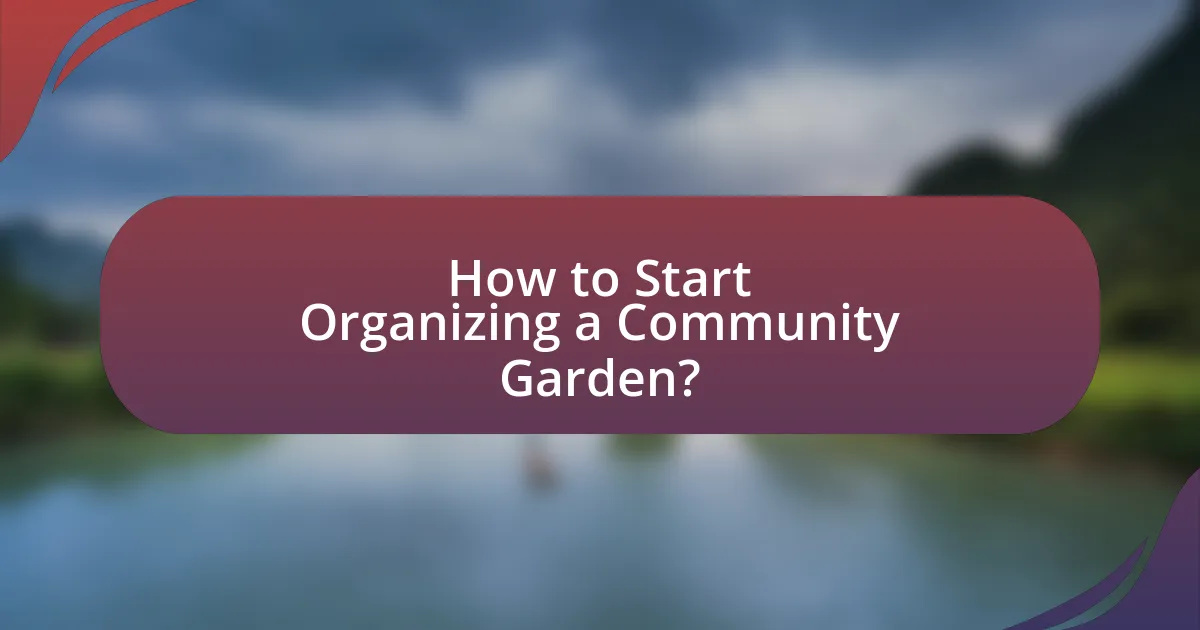
How to Start Organizing a Community Garden?
To start organizing a community garden, first, gather interested community members to form a planning committee. This committee should assess potential locations, secure land access, and establish goals for the garden, such as the types of plants to grow and community involvement. Research shows that community gardens can improve local food access and foster community engagement, as evidenced by a study from the American Community Gardening Association, which highlights the benefits of community gardens in urban areas.
What initial steps should be taken to organize a community garden?
To organize a community garden, the initial steps include gathering interested community members and identifying a suitable location for the garden. Engaging local residents fosters a sense of ownership and collaboration, while selecting a location with adequate sunlight, water access, and soil quality is crucial for successful gardening. Research indicates that community gardens can enhance social cohesion and improve access to fresh produce, making these initial steps vital for establishing a thriving garden.
How do you gather community interest and support?
To gather community interest and support for a community garden, actively engage local residents through informational meetings and outreach initiatives. Hosting events such as workshops or open houses allows community members to learn about the benefits of a garden, fostering a sense of ownership and involvement. Research indicates that community gardens can enhance social cohesion and improve local food access, which can motivate participation. For instance, a study by the American Community Gardening Association found that 85% of community gardeners reported increased community engagement and support for local initiatives.
What factors should be considered when selecting a location?
When selecting a location for a community garden, factors such as sunlight exposure, soil quality, water access, and proximity to the community must be considered. Sunlight exposure is crucial as most vegetables require at least six hours of direct sunlight daily for optimal growth. Soil quality should be assessed for nutrients and drainage; testing the soil can reveal its suitability for planting. Access to water is essential for irrigation, so proximity to a water source or the ability to install a water supply is important. Additionally, the location should be easily accessible to community members to encourage participation and maintenance. These factors collectively ensure the garden’s success and sustainability.
How can you form a planning committee?
To form a planning committee for a community garden, identify interested community members and stakeholders who are passionate about gardening and community development. Gather these individuals to discuss the purpose, goals, and structure of the committee, ensuring a diverse representation of the community. Establish roles and responsibilities within the committee, such as chairperson, secretary, and treasurer, to facilitate organization and decision-making. Schedule regular meetings to maintain engagement and progress, and create a clear agenda for each meeting to ensure productive discussions. This approach is effective as it fosters collaboration and ensures that various perspectives are considered in the planning process.
What roles and responsibilities should committee members have?
Committee members should have defined roles and responsibilities that facilitate the effective management of a community garden. These roles typically include a chairperson to lead meetings and coordinate activities, a treasurer to manage finances and budgeting, a secretary to document meetings and maintain records, and various committee members responsible for specific tasks such as outreach, maintenance, and event planning.
For instance, the chairperson ensures that the garden’s goals are met and that all members are engaged, while the treasurer oversees the financial health of the garden, which is crucial for sustainability. The secretary’s documentation helps maintain transparency and accountability, essential for community trust. Additionally, task-specific roles allow for efficient division of labor, ensuring that all aspects of the garden are attended to, from planting to community engagement. This structured approach is supported by successful community garden models, which emphasize the importance of clear roles for operational effectiveness.
How do you ensure diverse representation in the committee?
To ensure diverse representation in the committee, we actively recruit members from various demographic backgrounds, including different ethnicities, genders, ages, and socioeconomic statuses. This approach is supported by research indicating that diverse teams lead to more innovative solutions and better decision-making. For instance, a study by McKinsey & Company found that organizations with higher diversity levels are 35% more likely to outperform their peers in profitability. By implementing outreach strategies and partnerships with local organizations, we can effectively engage underrepresented groups, ensuring that the committee reflects the community’s diversity.

What are the Practical Steps for Setting Up a Community Garden?
To set up a community garden, first, gather a group of interested individuals to form a planning committee. This committee will help identify a suitable location, which should have access to sunlight, water, and good soil. Next, secure permission from landowners or local authorities to use the chosen site. After that, develop a garden plan that includes layout, types of plants, and shared responsibilities among members. Organize a community meeting to discuss the plan and gather input. Once the plan is finalized, prepare the site by clearing debris, tilling the soil, and adding compost. Finally, establish rules for garden use, maintenance, and harvest sharing to ensure a collaborative and sustainable environment.
How do you design the layout of the garden?
To design the layout of a garden, start by assessing the available space and sunlight exposure. This involves measuring the area, noting existing features like trees or structures, and determining how much sunlight different sections receive throughout the day. A well-planned layout should include designated areas for planting, pathways for accessibility, and communal spaces for gatherings. Research indicates that gardens with organized layouts improve plant health and community engagement, as seen in studies by the American Community Gardening Association, which highlight the benefits of structured garden designs in fostering community interaction and maximizing space efficiency.
What types of plants should be included in the garden?
A community garden should include a variety of plants such as vegetables, herbs, and flowers to maximize biodiversity and utility. Vegetables like tomatoes, peppers, and lettuce provide food, while herbs such as basil, cilantro, and mint enhance culinary experiences. Additionally, flowers like marigolds and sunflowers attract pollinators and improve the garden’s aesthetic appeal. Research indicates that diverse plantings can lead to healthier ecosystems and increased yields, as supported by studies from the American Community Gardening Association, which highlight the benefits of plant diversity in community gardens.
How do you plan for garden maintenance and upkeep?
To plan for garden maintenance and upkeep, create a detailed schedule that outlines tasks such as watering, weeding, pruning, and harvesting. This schedule should be based on the specific needs of the plants, seasonal changes, and the availability of volunteers. For instance, regular watering is essential during dry spells, while weeding should occur weekly to prevent competition for nutrients. Research indicates that gardens with structured maintenance plans yield 20-30% more produce compared to those without. By assigning specific responsibilities to community members, you ensure accountability and consistent care, which is crucial for the garden’s success.
What resources are needed for a successful community garden?
A successful community garden requires essential resources such as land, soil, water, tools, seeds or plants, and community involvement. Land provides the physical space for planting, while quality soil is crucial for healthy plant growth. Access to water is necessary for irrigation, and tools like shovels, rakes, and hoes facilitate gardening tasks. Seeds or plants are the starting point for cultivation, and active community involvement ensures maintenance and sustainability. Research indicates that community gardens can improve local food security and foster social connections, highlighting the importance of these resources in achieving success.
How can you secure funding and resources?
To secure funding and resources for a community garden, you can apply for grants, seek donations from local businesses, and organize fundraising events. Grants specifically for community gardens are available from organizations such as the USDA and local government programs, which often allocate funds for community development and green initiatives. Additionally, local businesses may provide sponsorships or in-kind donations, such as soil, seeds, or tools, in exchange for advertising opportunities. Fundraising events, such as bake sales or community potlucks, can also generate financial support while fostering community engagement.
What tools and materials are essential for starting a garden?
Essential tools and materials for starting a garden include a shovel, rake, hoe, trowel, watering can or hose, gloves, and seeds or seedlings. These tools facilitate soil preparation, planting, and maintenance. For instance, a shovel is crucial for digging and turning soil, while a rake helps level the ground and remove debris. Gloves protect hands during gardening tasks, and seeds or seedlings are necessary for growing plants. According to the National Gardening Association, having the right tools significantly enhances gardening efficiency and success rates.
What are common challenges faced in organizing a community garden?
Common challenges faced in organizing a community garden include securing land, managing diverse participant expectations, and maintaining ongoing engagement. Securing land often involves navigating local regulations and obtaining permissions, which can be time-consuming and complex. Managing diverse participant expectations is crucial, as individuals may have different visions for the garden, leading to conflicts or dissatisfaction. Maintaining ongoing engagement is essential for the garden’s sustainability; without regular participation and commitment from community members, the garden may struggle to thrive. These challenges are frequently documented in community gardening literature, highlighting the importance of clear communication and structured planning to address them effectively.
How can conflicts among community members be resolved?
Conflicts among community members can be resolved through open communication, mediation, and establishing clear guidelines. Open communication allows members to express their concerns and perspectives, fostering understanding. Mediation involves a neutral third party facilitating discussions to help reach a consensus. Establishing clear guidelines, such as conflict resolution protocols, can prevent misunderstandings and provide a framework for addressing issues. Research indicates that communities with structured conflict resolution processes experience fewer disputes and greater cohesion, highlighting the effectiveness of these methods in maintaining harmony.
What strategies can be used to overcome funding shortages?
To overcome funding shortages for a community garden, organizations can implement several strategies. First, they can seek grants from local government, non-profits, or foundations that support community development and environmental initiatives. For instance, the USDA Community Food Projects Competitive Grant Program provides funding specifically for projects that aim to increase food security in low-income communities.
Second, community gardens can engage in crowdfunding campaigns using platforms like GoFundMe or Kickstarter, which allow individuals to contribute small amounts that collectively can cover significant costs. Research shows that community-driven funding efforts can raise substantial amounts, as seen in successful campaigns that have funded similar projects.
Third, forming partnerships with local businesses can provide in-kind donations or sponsorships, reducing the financial burden on the garden. For example, local nurseries may donate plants or supplies in exchange for advertising opportunities at the garden.
Lastly, organizing fundraising events, such as bake sales, plant sales, or community dinners, can generate revenue while fostering community involvement. These events not only raise funds but also increase awareness and support for the garden.
What are the best practices for sustaining a community garden?
The best practices for sustaining a community garden include establishing a clear governance structure, fostering community involvement, and implementing sustainable gardening techniques. A governance structure, such as a committee, ensures organized decision-making and conflict resolution, which is essential for long-term success. Community involvement encourages participation and ownership, leading to increased commitment and shared responsibility among members. Sustainable gardening techniques, such as crop rotation, composting, and organic pest management, enhance soil health and biodiversity, contributing to the garden’s resilience. Research indicates that community gardens with active governance and community engagement have higher rates of sustainability and productivity, as evidenced by studies from the American Community Gardening Association.
How can you engage the community over time?
Engaging the community over time can be achieved by implementing regular events, consistent communication, and fostering a sense of ownership among participants. Organizing seasonal planting days, workshops, and harvest festivals encourages ongoing participation and strengthens community bonds. Consistent communication through newsletters, social media, and community boards keeps members informed and involved, while soliciting feedback ensures that their voices are heard. Additionally, involving community members in decision-making processes regarding garden management cultivates a sense of ownership, leading to sustained engagement. Research shows that community gardens with active participation and regular events see a 30% increase in volunteer retention over time, highlighting the effectiveness of these strategies.
What methods can be used to evaluate the garden’s success?
To evaluate a garden’s success, methods such as measuring crop yield, assessing plant health, and gathering community feedback can be employed. Measuring crop yield involves quantifying the amount of produce harvested, which provides a clear indicator of productivity. Assessing plant health includes monitoring growth rates, pest resistance, and overall vitality, which reflects the effectiveness of gardening practices. Gathering community feedback through surveys or meetings allows for insights into participant satisfaction and engagement, highlighting the social impact of the garden. These methods collectively provide a comprehensive evaluation of the garden’s success.
What tips can help ensure the success of a community garden?
To ensure the success of a community garden, it is essential to establish clear goals and involve the community in the planning process. Engaging local residents fosters ownership and commitment, which are critical for sustainability. Research indicates that community involvement increases participation rates and enhances the garden’s impact on local food security and social cohesion. Additionally, selecting a suitable location with adequate sunlight, water access, and soil quality is vital for plant growth. Regular maintenance schedules and shared responsibilities among members help keep the garden thriving. Studies show that gardens with organized management and consistent upkeep yield better results and foster community relationships.
